89 posts
Latest Posts by evisno - Page 2






Theories about the Origins of Space and Time. 1. Gravity as Thermodynamics Entropic gravity is a theory in modern physics that describes gravity as an entropic force - not a fundamental interaction mediated by a quantum field theory and a gauge particle, but a consequence of physical systems’ tendency to increase their entropy. 2. Loop Quantum Gravity According to Einstein, gravity is not a force – it is a property of space-time itself. Loop quantum gravity is an attempt to develop a quantum theory of gravity based directly on Einstein’s geometrical formulation. The main output of the theory is a physical picture of space where space is granular. More precisely, space can be viewed as an extremely fine fabric or network “woven” of finite loops. These networks of loops are called spin networks. The evolution of a spin network over time is called a spin foam. The predicted size of this structure is the Planck length, which is approximately 10−35 meters. According to the theory, there is no meaning to distance at scales smaller than the Planck scale. Therefore, LQG predicts that not just matter, but space itself, has an atomic structure. 3. Causal Sets Its founding principles are that spacetime is fundamentally discrete and that spacetime events are related by a partial order. The theory postulates that the building blocks of space-time are simple mathematical points that are connected by links, with each link pointing from past to future. Such a link is a bare-bones representation of causality, meaning that an earlier point can affect a later one, but not vice versa. The resulting network is like a growing tree that gradually builds up into space-time. 4. Causal Dynamical Triangulations The idea is to approximate the unknown fundamental constituents with tiny chunks of ordinary space-time caught up in a roiling sea of quantum fluctuations, and to follow how these chunks spontaneously glue themselves together into larger structures. The space-time building blocks were simple hyper-pyramids (four-dimensional counterparts to three-dimensional tetrahedrons) and the simulation’s gluing rules allowed them to combine freely. The result was a series of bizarre ‘universes’ that had far too many dimensions (or too few), and that folded back on themselves or broke into pieces. 5. Holography In this model, the three-dimensional interior of the universe contains strings and black holes governed only by gravity, whereas its two-dimensional boundary contains elementary particles and fields that obey ordinary quantum laws without gravity. Hypothetical residents of the three-dimensional space would never see this boundary, because it would be infinitely far away. But that does not affect the mathematics: anything happening in the three-dimensional universe can be described equally well by equations in the two-dimensional boundary, and vice versa.

Starfish larvae, like other microorganisms, use tiny hair-like cilia to move the fluid around them. By beating these cilia in opposite directions on different parts of their bodies, the larvae create vortices, as seen in the flow visualization above. The starfish larvae don’t use these vortices for swimming – to swim, you’d want to push all the fluid in the same direction. Instead the vortices help the larvae feed. The more vortices they create, the more it stirs the fluid around them and draws in algae from far away. The larvae actually switch gears regularly, using few vortices when they want to swim and more when they want to eat. Check out the full video below to see the full explanation and more beautiful footage. (Image/video credit: W. Gilpin et al.)
![WATCH: Crystal Birth, A Beautiful Timelapse Of Metallic Crystals Forming In Chemical Solutions [video]](https://64.media.tumblr.com/a6b789bd547bb0fc1e3119df87332f1a/tumblr_oghrhqfMiX1rte5gyo2_500.gif)
![WATCH: Crystal Birth, A Beautiful Timelapse Of Metallic Crystals Forming In Chemical Solutions [video]](https://64.media.tumblr.com/0c08f977f51ba218837b72a94f7bbd69/tumblr_oghrhqfMiX1rte5gyo4_500.gif)
![WATCH: Crystal Birth, A Beautiful Timelapse Of Metallic Crystals Forming In Chemical Solutions [video]](https://64.media.tumblr.com/94f32be0db445db0cdfe2546b015295b/tumblr_oghrhqfMiX1rte5gyo1_500.gif)
![WATCH: Crystal Birth, A Beautiful Timelapse Of Metallic Crystals Forming In Chemical Solutions [video]](https://64.media.tumblr.com/333f1f1da60d5ff8500aa7a751dba6c4/tumblr_oghrhqfMiX1rte5gyo3_500.gif)
WATCH: Crystal Birth, a Beautiful Timelapse of Metallic Crystals Forming in Chemical Solutions [video]

Saturn’s hexagon is a hexagonal cloud pattern that has persisted at the North Pole of Saturn since its discovery in 1981. At the time, Cassini was only able to take infrared photographs of the phenomenon until it passed into sunlight in 2009, at which point amateur photographers managed to be able to photograph it from Earth.
The structure is roughly 20,000 miles (32,000 km) wide, which is larger than Earth; and thermal images show that it reaches roughly 60 miles (100 km) down into Saturn’s interior.
Read an explanation of how Saturn’s hexagon works here: [x]
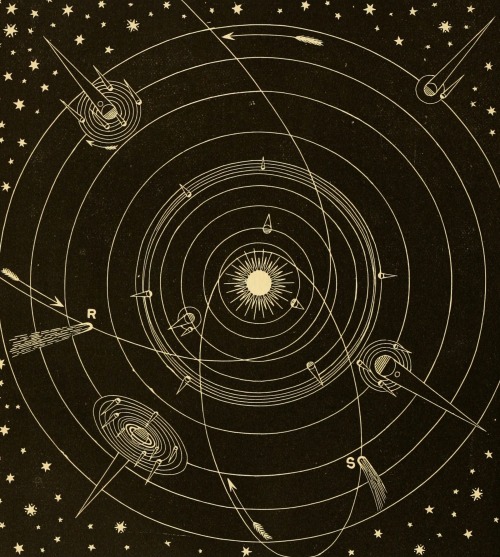
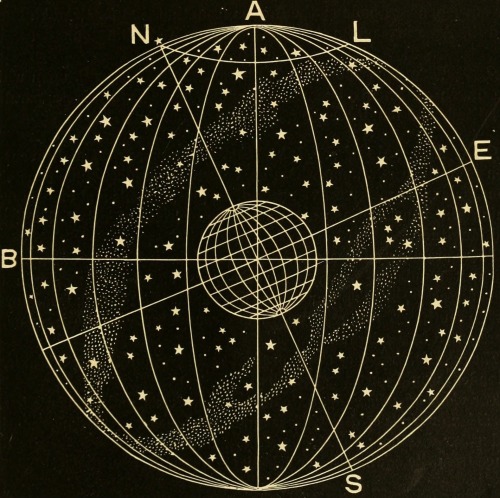
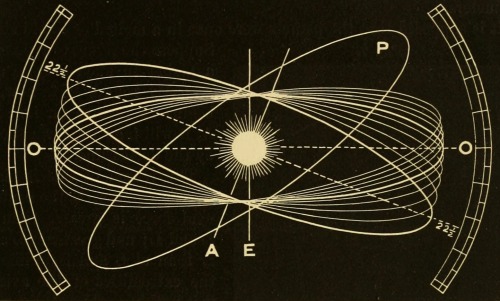
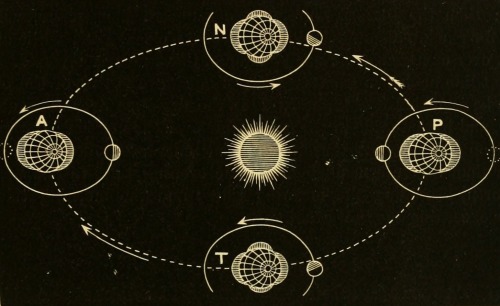
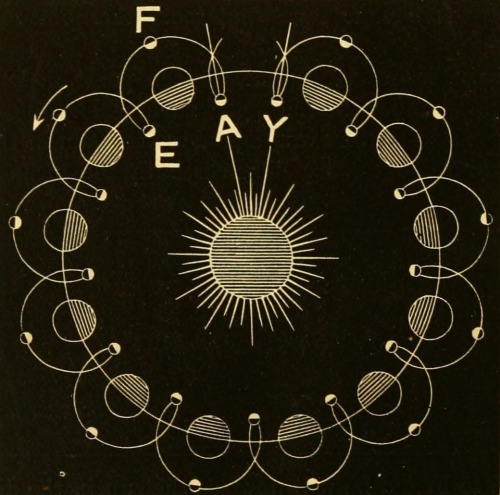
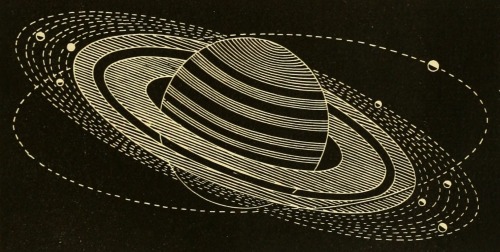
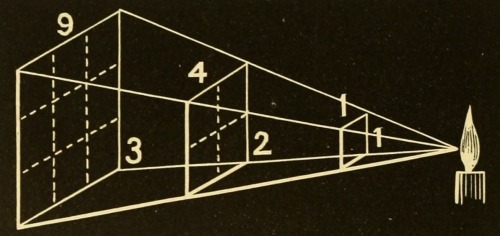
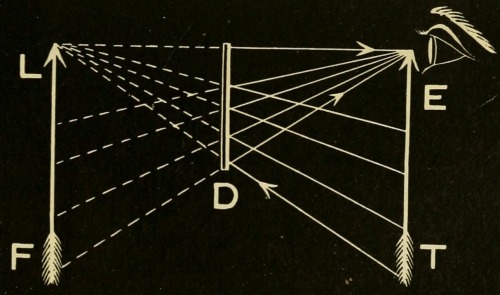
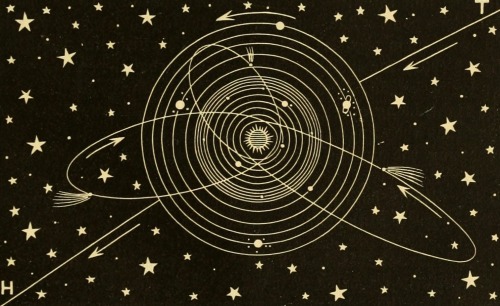
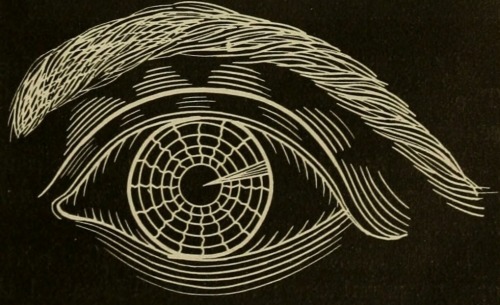
Frank G. Johnson. Solar System, Celestial and Terrestrial Latitude, The Ecliptic, Spring and Neap Tides, The Moon’s Path Around the Sun, Saturn’s Rings, Intensity of Light at Different Distances, The Optics of Plane Mirrors, The Orbit of the Sun, Method of Adjusting the Pupil or Aperture of the Eye. Johnson’s Natural Philosophy, and Key to Philosophical Charts. 1872.

Cosmic horseshoe is not the lucky beacon
A UC Riverside-led team of astronomers use observations of a gravitationally lensed galaxy to measure the properties of the early universe
Although the universe started out with a bang it quickly evolved to a relatively cool, dark place. After a few hundred thousand years the lights came back on and scientists are still trying to figure out why.
Astronomers know that reionization made the universe transparent by allowing light from distant galaxies to travel almost freely through the cosmos to reach us.
However, astronomers don’t fully understand the escape rate of ionizing photons from early galaxies. That escape rate is a crucial, but still a poorly constrained value, meaning there are a wide range of upper and lower limits in the models developed by astronomers.
That limitation is in part due to the fact that astronomers have been limited to indirect methods of observation of ionizing photons, meaning they may only see a few pixels of the object and then make assumptions about unseen aspects. Direct detection, or directly observing an object such as a galaxy with a telescope, would provide a much better estimate of their escape rate.
In a just-published paper, a team of researchers, led by a University of California, Riverside graduate student, used a direct detection method and found the previously used constraints have been overestimated by five times.
“This finding opens questions on whether galaxies alone are responsible for the reionization of the universe or if faint dwarf galaxies beyond our current detection limits have higher escape fractions to explain radiation budget necessary for the reionization of the universe,” said Kaveh Vasei, the graduate student who is the lead author of the study.
It is difficult to understand the properties of the early universe in large part because this was more than 12 billion year ago. It is known that around 380,000 years after the Big Bang, electrons and protons bound together to form hydrogen atoms for the first time. They make up more than 90 percent of the atoms in the universe, and can very efficiently absorb high energy photons and become ionized.
However, there were very few sources to ionize these atoms in the early universe. One billion years after the Big Bang, the material between the galaxies was reionized and became more transparent. The main energy source of the reionization is widely believed to be massive stars formed within early galaxies. These stars had a short lifespan and were usually born in the midst of dense gas clouds, which made it very hard for ionizing photons to escape their host galaxies.
Previous studies suggested that about 20 percent of these ionizing photons need to escape the dense gas environment of their host galaxies to significantly contribute to the reionization of the material between galaxies.
Unfortunately, a direct detection of these ionizing photons is very challenging and previous efforts have not been very successful. Therefore, the mechanisms leading to their escape are poorly understood.
This has led many astrophysicists to use indirect methods to estimate the fraction of ionizing photons that escape the galaxies. In one popular method, the gas is assumed to have a “picket fence” distribution, where the space within galaxies is assumed to be composed of either regions of very little gas, which are transparent to ionizing light, or regions of dense gas, which are opaque. Researchers can determine the fraction of each of these regions by studying the light (spectra) emerging from the galaxies.
In this new UC Riverside-led study, astronomers directly measured the fraction of ionizing photons escaping from the Cosmic Horseshoe, a distant galaxy that is gravitationally lensed. Gravitational lensing is the deformation and amplification of a background object by the curving of space and time due to the mass of a foreground galaxy. The details of the galaxy in the background are therefore magnified, allowing researchers to study its light and physical properties more clearly.
Based on the picket fence model, an escape fraction of 40 percent for ionizing photons from the Horseshoe was expected. Therefore, the Horseshoe represented an ideal opportunity to get for the first time a clear, resolved image of leaking ionizing photons to help understand the mechanisms by which they escape their host galaxies.
The research team obtained a deep image of the Horseshoe with the Hubble Space Telescope in an ultraviolet filter, enabling them to directly detect escaping ionizing photons. Surprisingly, the image did not detect ionizing photons coming from the Horseshoe. This team constrained the fraction of escaping photons to be less than 8 percent, five times smaller than what had been inferred by indirect methods widely used by astronomers.
“The study concludes that the previously determined fraction of escaping ionizing radiation of galaxies, as estimated by the most popular indirect method, is likely overestimated in many galaxies,” said Brian Siana, co-author of the research paper and an assistant professor at UC Riverside.
“The team is now focusing on direct determination the fraction of escaping ionizing photons that do not rely on indirect estimates.”










New Supernova Results: Is The Universe Not Accelerating?
“There actually is a nice result from this paper: it perhaps will cause a rethink of the standard likelihood analysis used by teams analyzing supernova data. It also shows just how incredible our data is: even with using none of our knowledge about the matter in the Universe or the flatness of space, we can still arrive at a better-than-3σ result supporting an accelerating Universe. But it also underscores something else that’s far more important. Even if all of the supernova data were thrown out and ignored, we have more than enough evidence at present to be extremely confident that the Universe is accelerating, and made of about 2/3 dark energy.”
Just a few days ago, a new paper was published in the journal Scientific Reports claiming that the evidence for acceleration from Type Ia supernovae was much flimsier than anyone gave it credit for. Rather than living up to the 5-sigma standard for scientific discovery, the authors claimed that there was only marginal, 3-sigma evidence for any sort of acceleration, despite having statistics that were ten times better than the original 1998 announcement. They claimed that an improved likelihood analysis combined with a rejection of all other priors explains why they obtained this result, and use it to cast doubt on not only the concordance model of cosmology, but on the awarding of the 2011 Nobel Prize for dark energy. Despite the sensational coverage this has gotten in the press, the team does quite a few things that are a tremendous disservice to the good science that has been done, and even a simplistic analysis clearly debunks their conclusions.
Dark energy and acceleration are real and here to stay. You owe it to yourself to find out why and how!
Celebrating 10 Years of Revolutionary Solar Views
Twin spacecraft give humanity unprecedented views of the entire sun at one time, traveling to the far side of our home star over the course of a 10-year mission.

These two spacecraft are called STEREO, short for Solar and Terrestrial Relations Observatory. Launched on Oct. 25, 2006, and originally slated for a two-year mission, both spacecraft sent back data for nearly eight years, and STEREO-A still sends information and images from its point of view on the far side of the sun.

STEREO watches the sun from two completely new perspectives. It also provides information invaluable for understanding the sun and its impact on Earth, other worlds, and space itself – collectively known as space weather. On Earth, space weather can trigger things like the aurora and, in extreme cases, put a strain on power systems or damage high-flying satellites.
Because the rest of our sun-watching satellites orbit near our home planet, STEREO’s twin perspectives far from Earth give us a unique opportunity to look at solar events from all sides and understand them in three dimensions.

We use data from STEREO and other missions to understand the space environment throughout the solar system. This helps operators for missions in deep space prepare for the sudden bursts of particles and magnetic field that could pose a danger to their spacecraft.

STEREO has also helped us understand other objects in our solar system – like comets. Watching how a comet’s tail moves gives us clues about the constant stream of particles that flows out from the sun, called the solar wind.

STEREO is an essential piece of our heliophysics fleet, which includes 17 other missions. Together, these spacecraft shed new light on the sun and its interaction with space, Earth, and other worlds throughout the solar system.
To celebrate, we’re hosting a Facebook Live event on Wednesday, Oct. 26. Join us at noon ET on the NASA Sun Science Facebook page to learn more about STEREO and ask questions.
Learn more about how NASA studies the sun at: www.nasa.gov/stereo
Follow us on Tumblr for your regular dose of space: http://nasa.tumblr.com
Solar System: Things to Know This Week
Learn the latest on Cassini’s Grand Finale, Pluto, Hubble Space Telescope and the Red Planet.
1. Cassini’s Grand Finale

After more than 12 years at Saturn, our Cassini mission has entered the final year of its epic voyage to the giant planet and its family of moons. But the journey isn’t over. The upcoming months will be like a whole new mission, with lots of new science and a truly thrilling ride in the unexplored space near the rings. Later this year, the spacecraft will fly repeatedly just outside the rings, capturing the closest views ever. Then, it will actually orbit inside the gap between the rings and the planet’s cloud tops.
Get details on Cassini’s final mission
The von Kármán Lecture Series: 2016
2. Chandra X-Rays Pluto

As the New Horizon’s mission headed to Pluto, our Chandra X-Ray Observatory made the first detection of the planet in X-rays. Chandra’s observations offer new insight into the space environment surrounding the largest and best-known object in the solar system’s outermost regions.
See Pluto’s X-Ray
3. … And Then Pluto Painted the Town Red

When the cameras on our approaching New Horizons spacecraft first spotted the large reddish polar region on Pluto’s largest moon, Charon, mission scientists knew two things: they’d never seen anything like it before, and they couldn’t wait to get the story behind it. After analyzing the images and other data that New Horizons has sent back from its July 2015 flight through the Pluto system, scientists think they’ve solved the mystery. Charon’s polar coloring comes from Pluto itself—as methane gas that escapes from Pluto’s atmosphere and becomes trapped by the moon’s gravity and freezes to the cold, icy surface at Charon’s pole.
Get the details
4. Pretty as a Postcard

The famed red-rock deserts of the American Southwest and recent images of Mars bear a striking similarity. New color images returned by our Curiosity Mars rover reveal the layered geologic past of the Red Planet in stunning detail.
More images
5. Things Fall Apart

Our Hubble Space Telescope recently observed a comet breaking apart. In a series of images taken over a three-day span in January 2016, Hubble captured images of 25 building-size blocks made of a mixture of ice and dust drifting away from the comet. The resulting debris is now scattered along a 3,000-mile-long trail, larger than the width of the continental U.S.
Learn more
Discover the full list of 10 things to know about our solar system this week HERE.
Make sure to follow us on Tumblr for your regular dose of space: http://nasa.tumblr.com
Solar System: Things to Know This Week
There’s even more to Mars.

1. Batten Down the Hatches
Good news for future astronauts: scientists are closer to being able to predict when global dust storms will strike the Red Planet. The winds there don’t carry nearly the same force that was shown in the movie “The Martian,” but the dust lofted by storms can still wreak havoc on people and machines, as well as reduce available solar energy. Recent studies indicate a big storm may be brewing during the next few months.
+ Get the full forecast

2. Where No Rover Has Gone Before
Our Opportunity Mars rover will drive down an ancient gully that may have been carved by liquid water. Several spacecraft at Mars have observed such channels from a distance, but this will be the first up-close exploration. Opportunity will also, for the first time, enter the interior of Endeavour Crater, where it has worked for the last five years. All this is part of a two-year extended mission that began Oct. 1, the latest in a series of extensions going back to the end of Opportunity’s prime mission in April 2004. Opportunity landed on Mars in January of that year, on a mission planned to last 90 Martian days (92.4 Earth days). More than 12 Earth years later, it’s still rolling.
+ Follow along + See other recent pictures from Endeavour Crater

3. An Uphill Climb
Opportunity isn’t the only NASA Mars rover getting a mission extension. On the other side of the planet, the Curiosity rover is driving and collecting samples amid some of the most scenic landscapes ever visited on Mars. Curiosity’s two-year mission extension also began Oct. 1. It’s driving toward uphill destinations, including a ridge capped with material rich in the iron-oxide mineral hematite, about a mile-and-a-half (two-and-a-half kilometers) ahead. Beyond that, there’s an exposure of clay-rich bedrock. These are key exploration sites on lower Mount Sharp, which is a layered, Mount-Rainier-size mound where Curiosity is investigating evidence of ancient, water-rich environments that contrast with the harsh, dry conditions on the surface of Mars today.
+ Learn more

4. Keep a Sharp Lookout
Meanwhile, the Mars Reconnaissance Orbiter continues its watch on the Red Planet from above. The mission team has just released a massive new collection of super-high-resolution images of the Martian surface.
+ Take a look

5. 20/20 Vision for the 2020 Rover
In the year 2020, Opportunity and Curiosity will be joined by a new mobile laboratory on Mars. In the past week, we tested new “eyes” for that mission. The Mars 2020 rover’s Lander Vision System helped guide the rocket to a precise landing at a predesignated target. The system can direct the craft toward a safe landing at its primary target site or divert touchdown toward better terrain if there are hazards in the approaching target area.
+ Get details
Discover the full list of 10 things to know about our solar system this week HERE.
Make sure to follow us on Tumblr for your regular dose of space: http://nasa.tumblr.com
Why Bennu?
Our OSIRIS-REx spacecraft will travel to a near-Earth asteroid, called Bennu, where it will collect a sample to bring back to Earth for study.
But why was Bennu chosen as the target destination asteroid for OSIRIS-REx? The science team took into account three criteria: accessibility, size and composition.

Accessibility: We need an asteroid that we can easily travel to, retrieve a sample from and return to Earth, all within a few years time. The closest asteroids are called near-Earth objects and they travel within 1.3 Astronomical Units (AU) of the sun. For those of you who don’t think in astronomical units…one Astronomical Unit is approximately equal to the distance between the sun and the Earth: ~93 million miles.

For a mission like OSIRIS-REx, the most accessible asteroids are somewhere between 0.08 – 1.6 AU. But we also needed to make sure that those asteroids have a similar orbit to Earth. Bennu fit this criteria! Check!
Size: We need an asteroid the right size to perform two critical portions of the mission: operations close to the asteroid and the actual sample collection from the surface of the asteroid. Bennu is roughly spherical and has a rotation period of 4.3 hours, which is in our size criteria. Check!

Composition: Asteroids are categorized by their spectral properties. In the visible and infrared light minerals have unique signatures or colors, much like fingerprints. Scientists use these fingerprints to identify molecules, like organics. For primitive, carbon-rich asteroids like Bennu, materials are preserved from over 4.5 billion years ago! We’re talking about the start of the formation of our solar system here! These primitive materials could contain organic molecules that may be the precursors to life here on Earth, or elsewhere in our solar system.

Thanks to telescopic observations in the visible and the infrared, as well as in radar, Bennu is currently the best understood asteroid not yet visited by a spacecraft.
All of these things make Bennu a fascinating and accessible asteroid for the OSIRIS-REx mission.
Make sure to follow us on Tumblr for your regular dose of space: http://nasa.tumblr.com




Jupiter’s Galilean Moons
Io - Jupiter’s volcanic moon
Europa - Jupiter’s icy moon
Ganymede - Jupiter’s (and the solar system’s) largest moon
Callisto - Jupiter’s heavily cratered moon
Made using: Celestia, Screen2Gif & GIMP Based on: @spaceplasma‘s solar system gifs Profile sources: http://solarsystem.nasa.gov/planets, http://nssdc.gsfc.nasa.gov/planetary/factsheet/joviansatfact.html










Ask Ethan: How Do We Know The Universe Is 13.8 Billion Years Old?
“You’ve heard the story before: the Universe began with the Big Bang 13.8 billion years ago, and formed atoms, stars, galaxies, and eventually planets with the right ingredients for life. Looking at distant locations in the Universe is also looking back in time, and somehow, through the power of physics and astronomy, we’ve figured out not only how the Universe began, but its age. But how do we know how old the Universe is? That what Thys Hauptfleisch wants to know for this week’s Ask Ethan:
Ethan, how was the 13.8 billion years calculated? (In English please!)”
There’s a unique relationship between everything that exists in the Universe today – the stars and galaxies, the large-scale structure, the leftover glow from the Big Bang, the expansion rate, etc. – and the amount of time that’s passed since it all began. When it comes to our Universe, there really was a day without a yesterday, but how do we know exactly how much time has passed between then and now? There are two ways: one complex and one simple. The complex way is to determine all the matter and energy components making up the Universe, to measure how the Universe has expanded over the entirety of its cosmic history, and then, in the context of the Big Bang, to deduce how old the Universe must be. The other is to understand stars, measure them, and determine how old the oldest ones are.
The complex answer is more accurate, but more importantly, they both agree with each other. Get the details on this week’s Ask Ethan!

S-IC Built for Apollo 19
by Ian E. Abbott
Look Up! Perseid Meteor Shower Peaks Aug. 11-12
Asteroid Watch logo. Aug. 2, 2016 Make plans now to stay up late or set the alarm early next week to see a cosmic display of “shooting stars” light up the night sky. Known for it’s fast and bright meteors, the annual Perseid meteor shower is anticipated to be one of the best potential meteor viewing opportunities this year. The Perseids show up every year in August when Earth ventures through trails of debris left behind by an ancient comet. This year, Earth may be in for a closer encounter than usual with the comet trails that result in meteor shower, setting the stage for a spectacular display.
Image above: An outburst of Perseid meteors lights up the sky in August 2009 in this time-lapse image. Stargazers expect a similar outburst during next week’s Perseid meteor shower, which will be visible overnight on Aug. 11 and 12. Image Credits: NASA/JPL. “Forecasters are predicting a Perseid outburst this year with double normal rates on the night of Aug. 11-12,” said Bill Cooke with NASA’s Meteoroid Environments Office in Huntsville, Alabama. “Under perfect conditions, rates could soar to 200 meteors per hour.” An outburst is a meteor shower with more meteors than usual. The last Perseid outburst occurred in 2009. Every Perseid meteor is a tiny piece of the comet Swift-Tuttle, which orbits the sun every 133 years. Each swing through the inner solar system can leave trillions of small particles in its wake. When Earth crosses paths with Swift-Tuttle’s debris, specks of comet-stuff hit Earth’s atmosphere and disintegrate in flashes of light. These meteors are called Perseids because they seem to fly out of the constellation Perseus. Most years, Earth might graze the edge of Swift-Tuttle’s debris stream, where there’s less activity. Occasionally, though, Jupiter’s gravity tugs the huge network of dust trails closer, and Earth plows through closer to the middle, where there’s more material. This may be one of those years. Experts at NASA and elsewhere agree that three or more streams are on a collision course with Earth. “Here’s something to think about. The meteors you’ll see this year are from comet flybys that occurred hundreds if not thousands of years ago,” said Cooke. “And they’ve traveled billions of miles before their kamikaze run into Earth’s atmosphere.” How to Watch the Perseids The best way to see the Perseids is to go outside between midnight and dawn on the morning of Aug. 12. Allow about 45 minutes for your eyes to adjust to the dark. Lie on your back and look straight up. Increased activity may also be seen on Aug. 12-13. For stargazers experiencing cloudy or light-polluted skies, a live broadcast of the Perseid meteor shower will be available via Ustream overnight on Aug. 11-12 and Aug. 13-14, beginning at 10 p.m. EDT.: http://www.ustream.tv/channel/nasa-msfc
Meteor Moment: Viewing Tips.
More about the Perseids Perseid meteors travel at the blistering speed of 132,000 miles per hour (59 kilometers per second). That’s 500 times faster than the fastest car in the world. At that speed, even a smidgen of dust makes a vivid streak of light when it collides with Earth’s atmosphere. Peak temperatures can reach anywhere from 3,000 to 10,000 degrees Fahrenheit as they speed across the sky. The Perseids pose no danger to Earth. Most burn up 50 miles above our planet. But an outburst could mean trouble for spacecraft. About the Meteoroid Environment Office It’s Cooke’s job to help NASA understand and prepare for risks posed by meteoroids. He leads a team of meteor experts in the Meteoroid Environments Office at NASA’s Marshall Space Flight Center. They study meteoroids in space so that NASA can protect our nation’s satellites, spacecraft and even astronauts aboard the International Space Station from these bits of tiny space debris. Related links: Meteors & Meteorites: http://www.nasa.gov/topics/solarsystem/features/watchtheskies/index.html Meteoroid Environments Office: https://www.nasa.gov/offices/meo/home/index.html Image (mentioned), Video, Text, Credits: NASA/Jennifer Harbaugh. Greetings, Orbiter.ch Full article

Abell S1063, the final frontier by Hubble Space Telescope / ESA on Flickr.
Abell S1063, a galaxy cluster, was observed by the NASA/ESA Hubble Space Telescope as part of the Frontier Fields programme. The huge mass of the cluster acts as a cosmic magnifying glass and enlarges even more distant galaxies, so they become bright enough for Hubble to see. More information: www.spacetelescope.org/images/heic1615a/ Credit: NASA, ESA, and J. Lotz (STScI)



HIV virus particle, budding influenza virus and HIV in blood serum as illustrated by David S. Goodsell.
Goodsell is a professor at the Scripps Research Institute and is widely known for his scientific illustrations of life at a molecular scale. The illustrations are usually based on electron microscopy images and available protein structure data, which makes them more or less accurate. Each month a new illustrated protein structure can be found in Protein Data Bank molecule of the month section and you can read more on how his art is made here.

The Cat’s Eye Nebula (NGC 6543) is one of the best known planetary nebulae in the sky. Its more familiar outlines are seen in the brighter central region of the nebula in this impressive wide-angle view. But the composite image combines many short and long exposures to also reveal an extremely faint outer halo. At an estimated distance of 3,000 light-years, the faint outer halo is over 5 light-years across. Planetary nebulae have long been appreciated as a final phase in the life of a sun-like star. More recently, some planetary nebulae are found to have halos like this one, likely formed of material shrugged off during earlier episodes in the star’s evolution. While the planetary nebula phase is thought to last for around 10,000 years, astronomers estimate the age of the outer filamentary portions of this halo to be 50,000 to 90,000 years. Visible on the left, some 50 million light-years beyond the watchful planetary nebula, lies spiral galaxy NGC 6552.
Object Names: Cat’s Eye Nebula, NGC 6543
Image Type: Astronomical
Credit: Josh Smith (Via Nasa)
Time And Space

1976 … space station colonies
by x-ray delta one






Have Astronomers Found Alien Megastructures After All? (No, Probably Not)
“We’ve often found that — when it comes to unexpected astronomical signals — our imaginations run away with us, leading us to immediately jump to conclusions about our greatest hopes and/or fears, like the existence of sentient aliens accessible to us. But the real Universe, every time thus far, has shown itself to be more diverse, complex, and rich in phenomena than we had previously realized, including the existence of quasars, pulsars, exoplanets and more. We haven’t yet ruled out the possibility of alien megastructures, but what we’re most likely seeing is a new type of natural phenomena whose origin is yet unknown. Follow-up observations, particularly those scheduled for 2017, when another major “transit” event is scheduled to occur, should teach us a whole lot more.”
Last year, Penn State astronomer Jason Wright made headlines by claiming that one of the stars being observed by NASA’s Kepler mission might contain alien megastructures around it. The large dips in its light curve didn’t make sense in the context of planets, and the star KIC 8462852 became the target of a great many follow-ups. A binary companion was found, along with no signs of excess infrared emission or artificial radio signatures. However, archival data recently found that the star dimmed by about 20% over the past century. While the alien megastructures possibility cannot be ruled out, a great many other astrophysical possibilities still survive.





Comments of the Week #92: from the Universe’s birth to ten decades of science
“[I]f there were antimatter galaxies out there, then there should be some interface between the matter and antimatter ones. Either there would be a discontinuity (like a domain wall) separating the two regions, there would be an interface where gamma rays of a specific frequency originated, or there would be a great 2D void where it’s all already annihilated away.
And our Universe contains none of these things. The absence of them in all directions and in all locations tells us that if there are antimatter galaxies out there, they’re far beyond the observable part of our Universe. Instead, every interacting pair we see shows evidence that they’re all made of matter. Beautiful, beautiful matter.”
There’s no better way to start 2016 than… with a bang! Come check out our first comments of the week of the new year.

9 Squares 8
Top: David Stanfield, Skip Hursh, Jamie Muntean Middle: David Urbinati, Al Boardman, Jake Williams Bottom: Riccardo Albertini, Bee Grandinetti, Qais Sarhan
About the project

The making of Polylion

Quantum Tunneling
Quantum tunneling refers to the quantum mechanical phenomenon where a particle tunnels through a barrier that it classically could not surmount. This plays an essential role in several physical phenomena, such as the nuclear fusion that occurs in main sequence stars like the Sun. It has important applications to modern devices such as the tunnel diode, quantum computing, and the scanning tunneling microscope. The effect was predicted in the early 20th century and its acceptance as a general physical phenomenon came mid-century.
Tunneling is often explained using the Heisenberg uncertainty principle and the wave–particle duality of matter. Pure quantum mechanical concepts are central to the phenomenon, so quantum tunneling is one of the novel implications of quantum mechanics.
source


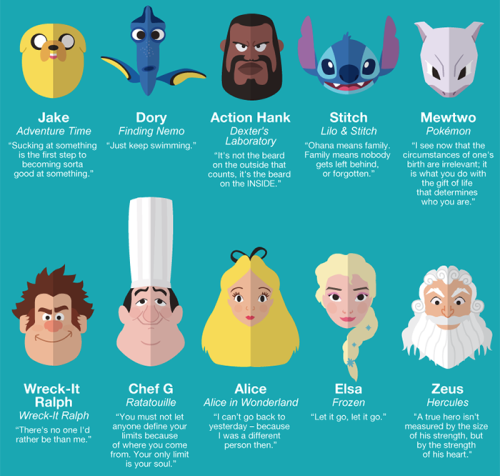
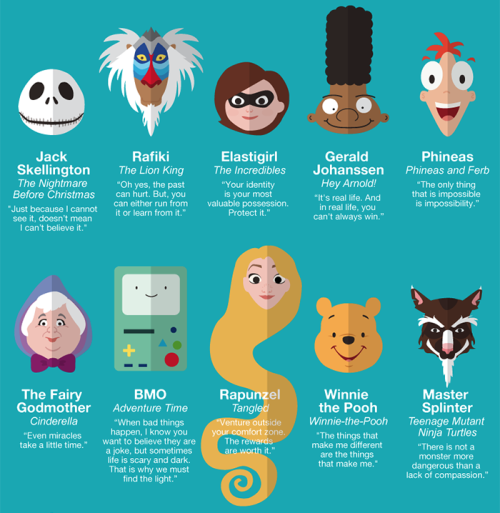


Life Advice from 50 Beloved Characters in Kid’s Entertainment by AAA State of Play -source-
NASA logo. April 27, 2015 As the saying goes, timing is everything. More so in 21st-century space exploration where navigating spacecraft precisely to far-flung destinations—say to Mars or even more distant Europa, a moon of Jupiter—is critical. NASA is making great strides...




Space Infographicsby Nick Wiinikka
prints/poster/phone cases and more by the artist available here




